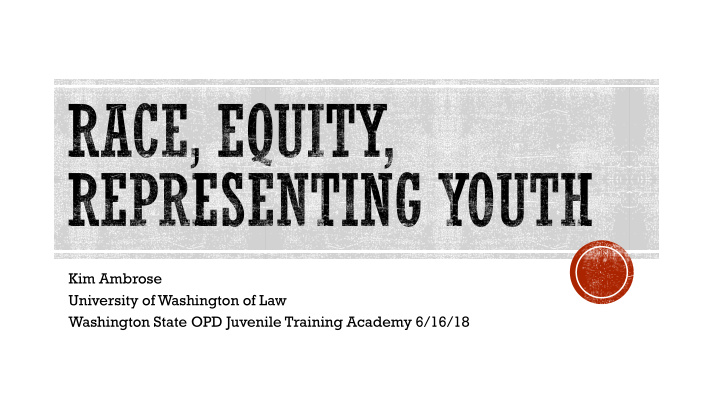



Kim Ambrose University of Washington of Law Washington State OPD Juvenile Training Academy 6/16/18
Current trends in RED (Racial and Ethnic Disparities) in Washington State A Quick Primer on Implicit Bias Where bias hits us: our role as defenders What we can do – practical steps
Understand what implicit bias is Identify how it impacts clients’ lives Identify where it operates in our practice Identify strategies for addressing our implicit bias Identify ways to challenge implicit bias in our cases
What you probably already know
Washington State, overall, files on youth of color* 2 times more often than white youth (RRI = 1.8) when compared to population percentages. RRI = 3.3 RRI = 2.3 RRI = 0.8 RRI = 1.3 Average RRI from 2010-2015, * excludes Asian youth
King County Detention '17 Asian 9% white Native Am. 17% 3% Hispanic 27% Black 44% white Black Hispanic Native Am. Asian
Non-white youth made up 75% of the youth under 18 charged as adults in Washington State in 2014. 50% of auto-decline youth were black. 24% Hispanic In 2015 in King County, only minority youth were automatically declined.
Overall arrest rate is down more than 60% in last 15 years. Overall incarceration in detention and JRA is down over 50% in last 15 years. Racial and Ethnic Disparities (RED) in filing and incarceration are increasing.
A moment to remember history and structural racism
Julia Lathrop 1858-1932 Jane Addams 1860-1935
Ida B. Wells (1862-1931)
“Segregation and poverty have created in the racial ghetto a destructive environment totally unknown to most white Americans. What white Americans have never fully understood—but what the Negro can never forget—is that white society is deeply implicated in the ghetto. White institutions created it, white institutions maintain, and white society condones it.” Police practices Unemployment and underemployment Inadequate housing Inadequate education Poor recreation facilities and programs Ineffectiveness of political structure and grievance mechanisms Disrespectful white attitudes Discriminatory administration of justice
Let’s take a look at ourselves, our role and what we can do.
Figure out ways to address our own implicit bias and how it may contribute to RED in the juvenile system.
GOOD DANCER GOOD ATHLETE LATINO GOOD AT MATH WHITE YOUTH GUNS GOOD STUDENT GANGMEMBER ASIAN YOUTH BLACK YOUTH
TMV THEFT 3 POSSESSION OF METH HISPANIC YOUTH GIRL CHILD MOLESTATION 1 ROB 1 BOY POSSESSION OF COCAINE ASSAULT 2 WHITE YOUTH BLACK YOUTH ASSAULT 4 - DV NATIVE AMERICAN YOUTH
Unconscious associations we make about racial groups.
Definition of heuristic : involving or serving as an aid to learning, discovery, or problem- solving by experimental and especially trial-and-error methods.
Heuristics are used to cope with huge amounts of information Implicit racial biases help us filter and manage information Implicit bias helps us make decisions more efficiently Unintentional and involuntary Not consciously accessible through introspection Includes stereotypes and attitudes Tend to strengthen over time Implicit bias affects behavior and judgment Implicit bias thrives where: Quick decision with little information When person is cognitively depleted, anxious, or distracted
Motivation matters Reduce decision making under implicit bias inducing conditions Time pressure Cognitive overload Anxiety or distraction Priming Focus on the individual Exposure Micro-messaging
It starts early It permeates how they are treated in school It is persistent and may come in the form of “micro-aggressions” It can lead to anger and related behaviors
WHERE/WHEN MIGHT IMPLICIT BIAS SHOW UP IN OUR WORK?
Evaluation of Evidence Biased Interactions Biased Acceptance of Punishments
How implicit bias works Affects how we interpret ambiguous evidence Presumption of guilt based on implicit associations Gut feelings Impact of implicit bias on clients Less effort spent investigating Less effort spent negotiating Pleading the innocent
How implicit bias works Affects how we interpret client’s verbal and non-verbal communication Our behavior impacts their behavior (behavioral confirmation) Affects our perception of client credibility Impact of implicit bias on clients Erodes client trust Unable to gather information Unable to ethically advise and communicate Perpetuates clients’ distrust of the system
How implicit bias works Implicit dehumanization Impact on our clients Less effort on dispo mitigation JRA and detention statistics Normalizes jail for children Juvenile incarceration predicts future criminal justice involvement
Motivation matters Resist decision making under implicit bias inducing conditions Time pressure Cognitive overload Anxiety or distraction Priming Focus on the individual Exposure Micro-messaging
How do we raise it in our cases? First appearance Detention review Motions practice Plea negotiations Trial Disposition Probation violation
Write it down Share it
Recommend
More recommend